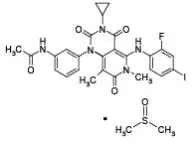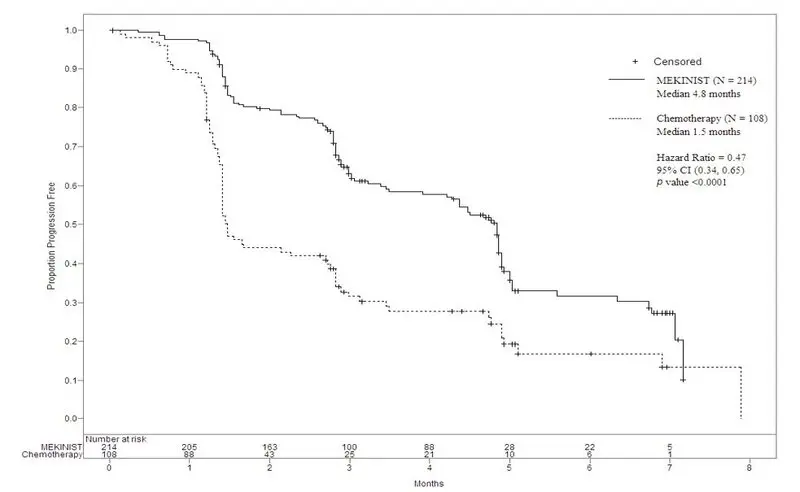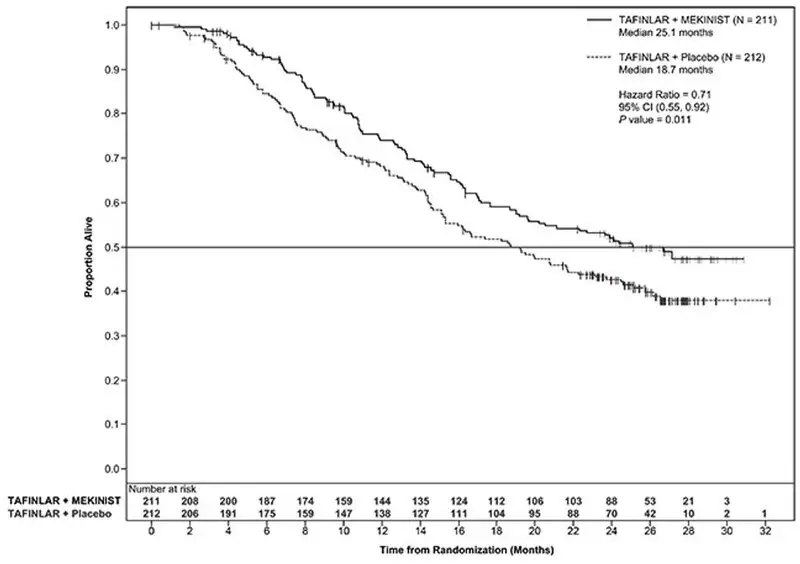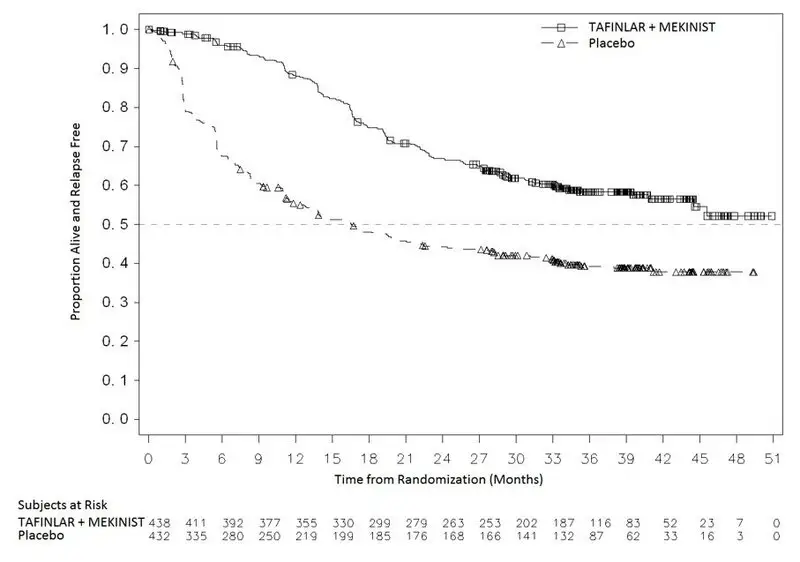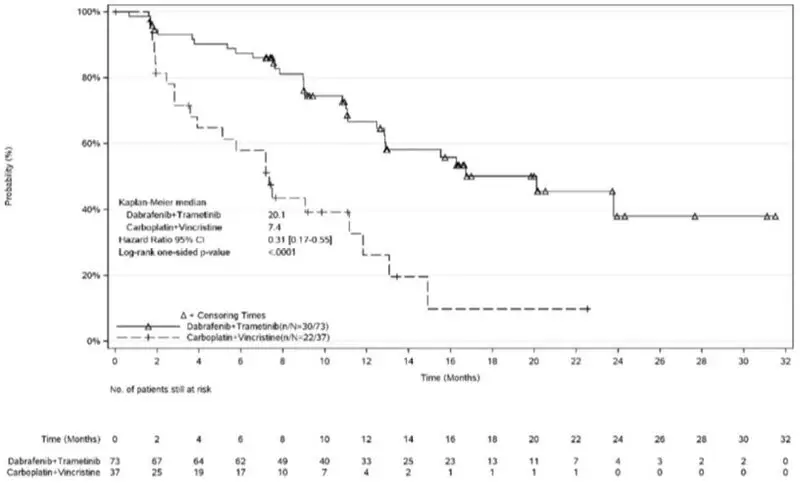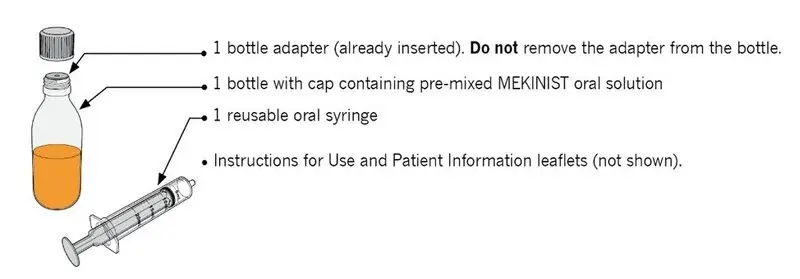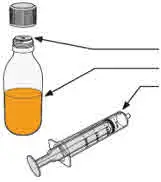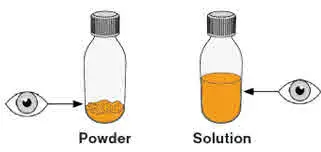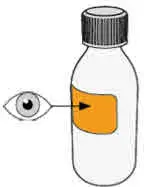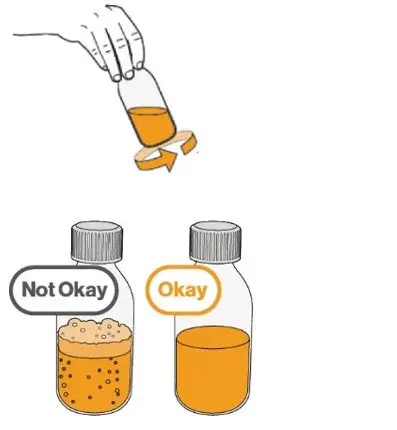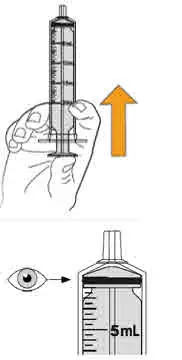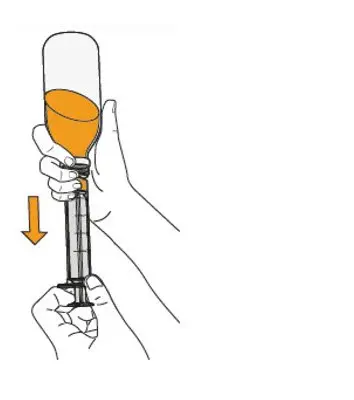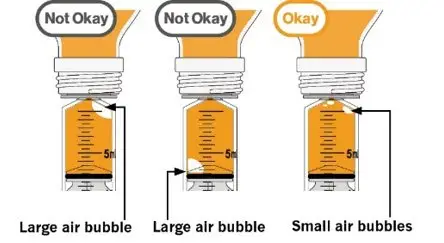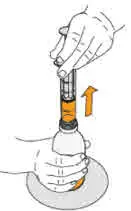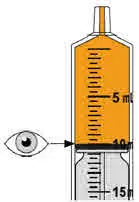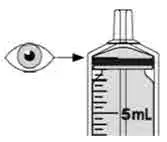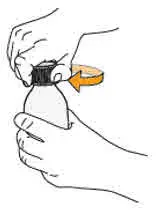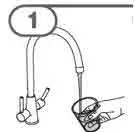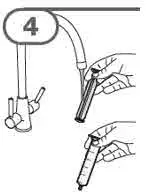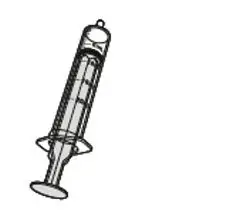Drug Detail:Mekinist (Trametinib [ tra-me-ti-nib ])
Drug Class: Multikinase inhibitors
Highlights of Prescribing Information
MEKINIST® (trametinib) tablets, for oral use
MEKINIST® (trametinib) for oral solution
Initial U.S. Approval: 2013
Recent Major Changes
| Indications and Usage, BRAF V600E Mutation-Positive Unresectable or Metastatic Solid Tumors (1.5) | 6/2022 |
| Indications and Usage, BRAF V600E Mutation-Positive Low-Grade Glioma (1.6) | 3/2023 |
| Indications and Usage, Limitations of Use (1.7) | 6/2022 |
| Dosage and Administration, Patient Selection (2.1) | 3/2023 |
| Dosage and Administration, Recommended Dosage (2.2) | 3/2023 |
| Dosage and Administration, Administration (2.3) | 3/2023 |
| Dosage and Administration, Dosage Modifications for Adverse Reactions (2.4) | 3/2023 |
| Warnings and Precautions, New Primary Malignancies (5.1) | 3/2023 |
| Warnings and Precautions, Hemorrhage (5.2) | 3/2023 |
| Warnings and Precautions, Colitis and Gastrointestinal Perforation (5.3) | 3/2023 |
| Warnings and Precautions, Venous Thromboembolic Events (5.4) | 3/2023 |
| Warnings and Precautions, Cardiomyopathy (5.5) | 3/2023 |
| Warnings and Precautions, Ocular Toxicities (5.6) | 3/2023 |
| Warnings and Precautions, Serious Febrile Reactions (5.8) | 3/2023 |
| Warnings and Precautions, Serious Skin Toxicities (5.9) | 3/2023 |
| Warnings and Precautions, Hyperglycemia (5.10) | 3/2023 |
| Warnings and Precautions, Hemophagocytic Lymphohistiocytosis (5.12) | 5/2023 |
Indications and Usage for Mekinist
MEKINIST is a kinase inhibitor indicated as a single agent for the treatment of BRAF-inhibitor treatment-naïve patients with unresectable or metastatic melanoma with BRAF V600E or V600K mutations as detected by an FDA-approved test. (1.1, 2.1)
MEKINIST is indicated, in combination with dabrafenib, for:
- the treatment of patients with unresectable or metastatic melanoma with BRAF V600E or V600K mutations as detected by an FDA-approved test. (1.1, 2.1)
- the adjuvant treatment of patients with melanoma with BRAF V600E or V600K mutations, as detected by an FDA-approved test, and involvement of lymph node(s), following complete resection. (1.2, 2.1)
- the treatment of patients with metastatic non-small cell lung cancer (NSCLC) with BRAF V600E mutation as detected by an FDA-approved test. (1.3, 2.1)
- the treatment of patients with locally advanced or metastatic anaplastic thyroid cancer (ATC) with BRAF V600E mutation and with no satisfactory locoregional treatment options. (1.4, 2.1)
- the treatment of adult and pediatric patients 6 years of age and older with unresectable or metastatic solid tumors with BRAF V600E mutation who have progressed following prior treatment and have no satisfactory alternative treatment options. This indication is approved under accelerated approval based on overall response rate and duration of response. Continued approval for this indication may be contingent upon verification and description of clinical benefit in a confirmatory trial(s). (1.5, 2.1)
- the treatment of pediatric patients 1 year of age and older with low-grade glioma (LGG) with a BRAF V600E mutation who require systemic therapy. (1.6, 2.1)
Limitations of Use: MEKINIST is not indicated for treatment of patients with colorectal cancer because of known intrinsic resistance to BRAF inhibition. (1.7, 12.1)
Mekinist Dosage and Administration
- The recommended dosage of MEKINIST in adult patients is 2 mg orally once daily. The recommended dosage for MEKINIST in pediatric patients is based on body weight. Take MEKINIST at least 1 hour before or at least 2 hours after a meal. (2)
Dosage Forms and Strengths
MEKINIST Tablets: 0.5 mg, 2 mg (3)
MEKINIST for Oral Solution: 4.7 mg (3)
Contraindications
None. (4)
Warnings and Precautions
- New Primary Malignancies, Cutaneous and Non-Cutaneous: Can occur when MEKINIST is used with dabrafenib. Monitor patients for new malignancies prior to, or while on therapy, and following discontinuation of treatment. (5.1)
- Hemorrhage: Major hemorrhagic events can occur. Monitor for signs and symptoms of bleeding. (5.2)
- Colitis and Gastrointestinal Perforation: Colitis and gastrointestinal perforation can occur in patients receiving MEKINIST. (5.3)
- Venous Thromboembolic Events: Deep vein thrombosis (DVT) and pulmonary embolism (PE) can occur in patients receiving MEKINIST. (5.4, 2.4)
- Cardiomyopathy: Assess left ventricular ejection fraction (LVEF) before treatment, after one month of treatment, then every 2 to 3 months thereafter. (5.5, 2.4)
- Ocular Toxicities: Perform ophthalmological evaluation for any visual disturbances. For Retinal Vein Occlusion (RVO), permanently discontinue MEKINIST. (5.6, 2.4)
- Interstitial Lung Disease (ILD)/Pneumonitis: Withhold MEKINIST for new or progressive unexplained pulmonary symptoms. Permanently discontinue MEKINIST for treatment-related ILD or pneumonitis. (5.7, 2.4)
- Serious Febrile Reactions: Can occur when MEKINIST is used with dabrafenib. (5.8, 2.4)
- Serious Skin Toxicities: Monitor for skin toxicities and for secondary infections. Permanently discontinue MEKINIST for intolerable Grade 2 or for Grade 3 or 4 rash not improving within 3 weeks despite interruption of MEKINIST. Permanently discontinue for severe cutaneous adverse reactions (SCARs). (5.9, 2.4)
- Hyperglycemia: Monitor serum glucose levels in patients with preexisting diabetes or hyperglycemia. (5.10)
- Hemophagocytic Lymphohistiocytosis (HLH): Interrupt treatment for suspected HLH. Discontinue treatment if HLH is confirmed. (5.12)
- Embryo-Fetal Toxicity: Can cause fetal harm. Advise females of reproductive potential of potential risk to a fetus and to use effective contraception. (5.13, 8.1, 8.3)
Adverse Reactions/Side Effects
Most common adverse reactions (≥ 20%) for MEKINIST as a single agent include rash, diarrhea, and lymphedema. (6.1)
Most common adverse reactions (≥ 20%) for MEKINIST in combination with dabrafenib include:
- Unresectable or metastatic melanoma: pyrexia, nausea, rash, chills, diarrhea, vomiting, hypertension, and peripheral edema. (6.1)
- Adjuvant treatment of melanoma: pyrexia, fatigue, nausea, headache, rash, chills, diarrhea, vomiting, arthralgia, and myalgia. (6.1)
- NSCLC: pyrexia, fatigue, nausea, vomiting, diarrhea, dry skin, decreased appetite, edema, rash, chills, hemorrhage, cough, and dyspnea. (6.1)
- Adult patients with solid tumors: pyrexia, fatigue, nausea, rash, chills, headache, hemorrhage, cough, vomiting, constipation, diarrhea, myalgia, arthralgia, and edema. (6.1)
- Pediatric patients with solid tumors: pyrexia, rash, vomiting, fatigue, dry skin, cough, diarrhea, dermatitis acneiform, headache, abdominal pain, nausea, hemorrhage, constipation, and paronychia. (6.1)
- Pediatric patients with LGG: pyrexia, rash, headache, vomiting, musculoskeletal pain, fatigue, diarrhea, dry skin, nausea, hemorrhage, abdominal pain, and dermatitis acneiform. (6.1)
To report SUSPECTED ADVERSE REACTIONS, contact Novartis Pharmaceuticals Corporation at 1-888-669-6682 or FDA at 1-800-FDA-1088 or www.fda.gov/medwatch.
Use In Specific Populations
- Lactation: Do not breastfeed. (8.2)
- Females and Males of Reproductive Potential: May impair fertility. Counsel patients on pregnancy planning and prevention. (8.3)
See 17 for PATIENT COUNSELING INFORMATION and FDA-approved patient labeling.
Revised: 5/2023
Full Prescribing Information
1. Indications and Usage for Mekinist
1.1 BRAF V600E or V600K Mutation-Positive Unresectable or Metastatic Melanoma
MEKINIST® is indicated, as a single agent in BRAF-inhibitor treatment-naïve patients or in combination with dabrafenib, for the treatment of patients with unresectable or metastatic melanoma with BRAF V600E or V600K mutations, as detected by an FDA-approved test [see Dosage and Administration (2.1)].
1.2 Adjuvant Treatment of BRAF V600E or V600K Mutation-Positive Melanoma
MEKINIST is indicated, in combination with dabrafenib, for the adjuvant treatment of patients with melanoma with BRAF V600E or V600K mutations as detected by an FDA-approved test, and involvement of lymph node(s), following complete resection [see Dosage and Administration (2.1)].
1.3 BRAF V600E Mutation-Positive Metastatic NSCLC
MEKINIST is indicated, in combination with dabrafenib, for the treatment of patients with metastatic non-small cell lung cancer (NSCLC) with BRAF V600E mutation as detected by an FDA-approved test [see Dosage and Administration (2.1)].
1.4 BRAF V600E Mutation-Positive Locally Advanced or Metastatic Anaplastic Thyroid Cancer
MEKINIST is indicated, in combination with dabrafenib, for the treatment of patients with locally advanced or metastatic anaplastic thyroid cancer (ATC) with BRAF V600E mutation and with no satisfactory locoregional treatment options [see Dosage and Administration (2.1)].
1.5 BRAF V600E Mutation-Positive Unresectable or Metastatic Solid Tumors
MEKINIST is indicated, in combination with dabrafenib, for the treatment of adult and pediatric patients 6 years of age and older with unresectable or metastatic solid tumors with BRAF V600E mutation who have progressed following prior treatment and have no satisfactory alternative treatment options [see Dosage and Administration (2.1)]. This indication is approved under accelerated approval based on overall response rate and duration of response [see Clinical Studies (14.6)]. Continued approval for this indication may be contingent upon verification and description of clinical benefit in a confirmatory trial(s).
2. Mekinist Dosage and Administration
2.1 Patient Selection
Melanoma
- Confirm the presence of BRAF V600E or V600K mutation in tumor specimens prior to initiation of treatment with MEKINIST as a single agent or in combination with dabrafenib [see Clinical Studies (14.1, 14.2)].
- Information on FDA-approved tests for the detection of BRAF V600 mutations in melanoma is available at: http://www.fda.gov/CompanionDiagnostics.
NSCLC
- Confirm the presence of BRAF V600E mutation in tumor specimens prior to initiation of treatment with MEKINIST and dabrafenib [see Clinical Studies (14.3)].
- Information on FDA-approved tests for the detection of BRAF V600E mutations in NSCLC is available at: http://www.fda.gov/CompanionDiagnostics.
ATC
- Confirm the presence of BRAF V600E mutation in tumor specimens prior to initiation of treatment with MEKINIST and dabrafenib [see Clinical Studies (14.4)]. An FDA-approved test for the detection of BRAF V600E mutation in ATC is not currently available.
Solid Tumors
- Confirm the presence of BRAF V600E mutation in tumor specimens prior to initiation of treatment with MEKINIST and dabrafenib [see Clinical Studies (14.6)]. An FDA-approved test for the detection of BRAF V600E mutation in solid tumors other than melanoma and NSCLC is not currently available.
Low-Grade Glioma
- Confirm the presence of BRAF V600E mutation in tumor specimens prior to initiation of treatment with MEKINIST and dabrafenib [see Clinical Studies (14.7)]. An FDA-approved test for the detection of BRAF V600E mutation in LGG is not currently available.
2.2 Recommended Dosage
MEKINIST Tablets
Adult Patients
The recommended dosage for MEKINIST tablets in adult patients is 2 mg orally taken once daily [see Dosage and Administration (2.3)].
Pediatric Patients
The recommended dosage for MEKINIST tablets in pediatric patients who weigh at least 26 kg is based on body weight (Table 1) [see Dosage and Administration (2.3)]. A recommended dosage of MEKINIST tablets has not been established in patients who weigh less than 26 kg.
| Body Weight | Recommended Dosage |
| 26 to 37 kg | 1 mg orally once daily |
| 38 to 50 kg | 1.5 mg orally once daily |
| 51 kg or greater | 2 mg orally once daily |
MEKINIST for Oral Solution
The recommended dosage for MEKINIST for oral solution is based on body weight (Table 2) [see Dosage and Administration (2.3)].
| Body Weight | Recommended Dosage Total Volume of Oral Solution Once Daily (Trametinib Content) |
| 8 kg | 6 mL (0.3 mg) |
| 9 kg | 7 mL (0.35 mg) |
| 10 kg | 7 mL (0.35 mg) |
| 11 kg | 8 mL (0.4 mg) |
| 12 to 13 kg | 9 mL (0.45 mg) |
| 14 to 17 kg | 11 mL (0.55 mg) |
| 18 to 21 kg | 14 mL (0.7 mg) |
| 22 to 25 kg | 17 mL (0.85 mg) |
| 26 to 29 kg | 18 mL (0.9 mg) |
| 30 to 33 kg | 20 mL (1 mg) |
| 34 to 37 kg | 23 mL (1.15 mg) |
| 38 to 41 kg | 25 mL (1.25 mg) |
| 42 to 45 kg | 28 mL (1.4 mg) |
| 46 to 50 kg | 32 mL (1.6 mg) |
| ≥ 51 kg | 40 mL (2 mg) |
- The recommended duration of treatment for patients with unresectable or metastatic melanoma or solid tumors, metastatic NSCLC, or locally advanced or metastatic anaplastic thyroid cancer is until disease progression or unacceptable toxicity.
- The recommended duration of treatment in the adjuvant melanoma setting is until disease recurrence or unacceptable toxicity for up to 1 year.
- The recommended duration of treatment for pediatric patients with LGG is until disease progression or until unacceptable toxicity.
Refer to the dabrafenib prescribing information for recommended dabrafenib dosing information.
2.3 Administration
- Take MEKINIST at the same time each day, approximately 24 hours apart.
- Take MEKINIST at least 1 hour before or 2 hours after a meal [see Clinical Pharmacology (12.3)].
- Do not take a missed dose of MEKINIST within 12 hours of the next dose of MEKINIST.
- If vomiting occurs after MEKINIST administration, do not take an additional dose. Take the next dose at its scheduled time.
MEKINIST Tablets
- Do not crush or break MEKINIST tablets.
MEKINIST for Oral Solution
- MEKINIST for oral solution is intended for administration by a caregiver. Prior to use of the oral solution, ensure caregivers receive training on proper dosing and administration of MEKINIST for oral solution.
Preparation and Administration
- To prepare MEKINIST for oral solution, tap the bottle until powder flows freely. Add 90 mL distilled or purified water to the powder in the bottle and invert or gently shake the bottle with re-attached cap for up to 5 minutes until powder is fully dissolved yielding a clear solution. Separate the dosing adapter from the oral syringe. Insert dosing adapter into bottle neck after reconstitution of the solution. Write the discard after date. Once reconstituted, MEKINIST oral solution can be used for 35 days.
- Administer MEKINIST for oral solution from oral dosing syringe or feeding tube.
- After reconstitution, store in original bottle below 25°C (77°F) and do not freeze.
2.4 Dosage Modifications for Adverse Reactions
Dose reductions for adverse reactions associated with MEKINIST are presented in Tables 3 and 4.
| Recommended Dosage | 1 mg orally once daily | 1.5 mg orally once daily | 2 mg orally once daily |
| First dose reduction | 0.5 mg orally once daily | 1 mg orally once daily | 1.5 mg orally once daily |
| Second dose reduction | N/A | 0.5 mg orally once daily | 1 mg orally once daily |
| Subsequent modification | Permanently discontinue MEKINIST tablets if unable to tolerate a maximum of two dose reductions. | ||
| Body Weight
(Recommended dosage) | First Dose Reduction | Second Dose Reduction |
| 8 kg [6 mL (0.3 mg)] | 5 mL | 3 mL |
| 9 kg [7 mL (0.35 mg)] | 5 mL | 4 mL |
| 10 kg [7 mL (0.35 mg)] | 5 mL | 4 mL |
| 11 kg [8 mL (0.4 mg)] | 6 mL | 4 mL |
| 12 to 13 kg [9 mL (0.45 mg)] | 7 mL | 5 mL |
| 14 to 17 kg [11 mL (0.55 mg)] | 8 mL | 6 mL |
| 18 to 21 kg [14 mL (0.7 mg)] | 11 mL | 7 mL |
| 22 to 25 kg [17 mL (0.85 mg)] | 13 mL | 9 mL |
| 26 to 29 kg [18 mL (0.9 mg)] | 14 mL | 9 mL |
| 30 to 33 kg [20 mL (1 mg)] | 15 mL | 10 mL |
| 34 to 37 kg [23 mL (1.15 mg)] | 17 mL | 12 mL |
| 38 to 41 kg [25 mL (1.25 mg)] | 19 mL | 13 mL |
| 42 to 45 kg [28 mL (1.4 mg)] | 21 mL | 14 mL |
| 46 to 50 kg [32 mL (1.6 mg)] | 24 mL | 16 mL |
| ≥ 51 kg [40 mL (2 mg)] | 30 mL | 20 mL |
| Permanently discontinue MEKINIST for oral solution if unable to tolerate a maximum of two dose reductions. | ||
Dosage modifications for adverse reactions associated with MEKINIST are presented in Table 5.
| a National Cancer Institute Common Terminology Criteria for Adverse Events (NCI CTCAE) version 4.0. b See Tables 3 and 4 for recommended dose reductions of MEKINIST. c Dose modifications are not recommended for MEKINIST when administered with dabrafenib for the following adverse reactions of dabrafenib: non-cutaneous malignancies and uveitis. Dose modification of MEKINIST is not required for new primary cutaneous malignancies. |
|
| Severity of Adverse Reactiona | Dosage Modification for MEKINISTb |
| Hemorrhage [see Warnings and Precautions (5.2)] | |
| Withhold MEKINIST.
|
| Permanently discontinue MEKINIST. |
| Venous Thromboembolic Events [see Warnings and Precautions (5.4)] | |
| Withhold MEKINIST for up to 3 weeks.
|
| Permanently discontinue MEKINIST. |
| Cardiomyopathy [see Warnings and Precautions (5.5)] | |
| Withhold MEKINIST for up to 4 weeks.
|
| Permanently discontinue MEKINIST. |
| Ocular Toxicities [see Warnings and Precautions (5.6)] | |
| Withhold MEKINIST for up to 3 weeks.
|
| Permanently discontinue MEKINIST. |
| Pulmonary [see Warnings and Precautions (5.7)] | |
| Permanently discontinue MEKINIST. |
| Febrile Reactions [see Warnings and Precautions (5.8)] | |
| Withhold MEKINIST until fever resolves, then resume MEKINIST at same or lower dose. |
|
|
| Skin Toxicities [see Warnings and Precautions (5.9)] | |
| Withhold MEKINIST for up to 3 weeks.
|
| Permanently discontinue MEKINIST. |
| Other Adverse Reactionsc | |
| Withhold MEKINIST.
|
|
|
| Permanently discontinue MEKINIST. |
Refer to the dabrafenib prescribing information for dose modifications for adverse reactions associated with dabrafenib.
3. Dosage Forms and Strengths
MEKINIST tablets:
- 0.5 mg tablets: Yellow, modified oval, biconvex, film-coated tablets with ‘GS’ debossed on one face and ‘TFC’ on the opposing face.
- 0.5 mg tablets: Yellow, ovaloid, biconvex, unscored film-coated tablets with beveled edges and with the Novartis logo debossed on one side and ‘TT’ on the other side.
- 2 mg tablets: Pink, round, biconvex, film-coated tablets with ‘GS’ debossed on one face and ‘HMJ’ on the opposing face.
- 2 mg tablets: Pink, round, biconvex, unscored film-coated tablets with beveled edges and with the Novartis logo debossed on one side and ‘LL’ on the other side.
MEKINIST for oral solution:
- White to almost white powder containing 4.7 mg of trametinib per bottle. Each mL of reconstituted strawberry-flavored trametinib solution contains 0.05 mg of trametinib.
5. Warnings and Precautions
5.1 New Primary Malignancies
Cutaneous Malignancies
MEKINIST Administered with Dabrafenib (Adult): In the pooled safety population [see Adverse Reactions (6.1)], cutaneous squamous cell carcinomas (cuSCCs) and keratoacanthomas occurred in 2% of patients. Basal cell carcinoma and new primary melanoma occurred in 3% and < 1% of patients, respectively.
MEKINIST Administered with Dabrafenib (Pediatric): In the pooled safety population, new primary melanoma occurred in < 1% of patients.
Perform dermatologic evaluations prior to initiation of MEKINIST when used with dabrafenib, every 2 months while on therapy, and for up to 6 months following discontinuation of the combination.
Non-Cutaneous Malignancies
Based on its mechanism of action, dabrafenib may promote growth and development of malignancies with activation of RAS through mutation or other mechanisms; refer to the prescribing information for dabrafenib.
In the pooled safety population of MEKINIST administered with dabrafenib, non-cutaneous malignancies occurred in 1% of patients.
Monitor patients receiving MEKINIST and dabrafenib closely for signs or symptoms of non-cutaneous malignancies. No dose modification is required for MEKINIST in patients who develop non-cutaneous malignancies.
5.2 Hemorrhage
Hemorrhages, including major hemorrhage defined as symptomatic bleeding in a critical area or organ, can occur with MEKINIST. Fatal cases have been reported.
MEKINIST Administered with Dabrafenib (Adult): In the pooled safety population [see Adverse Reactions (6.1)], hemorrhagic events occurred in 17% of patients; gastrointestinal hemorrhage occurred in 3% of patients; intracranial hemorrhage occurred in 0.6% of patients; fatal hemorrhage occurred in 0.5% of patients. The fatal events were cerebral hemorrhage and brainstem hemorrhage.
MEKINIST Administered with Dabrafenib (Pediatric): In the pooled safety population, hemorrhagic events occurred in 25% of patients; the most common type of bleeding was epistaxis (16%). Serious events of bleeding occurred in 3.6% of patients and included gastrointestinal hemorrhage (1.2%), cerebral hemorrhage (0.6%) uterine hemorrhage (0.6%), post-procedural hemorrhage (0.6%), and epistaxis (0.6%).
Permanently discontinue MEKINIST for all Grade 4 hemorrhagic events and for any Grade 3 hemorrhagic events that do not improve. Withhold MEKINIST for Grade 3 hemorrhagic events; if improved, resume at the next lower dose level.
5.3 Colitis and Gastrointestinal Perforation
Colitis and gastrointestinal perforation, including fatal outcomes, have been reported in patients taking:
MEKINIST Monotherapy and Administered with Dabrafenib (Adult): In the pooled safety population [see Adverse Reactions (6.1)], colitis occurred in < 1% of patients and gastrointestinal perforation occurred in < 1% of patients.
MEKINIST Administered with Dabrafenib (Pediatric): In the pooled safety population, colitis events occurred in <1% of patients.
Monitor patients closely for colitis and gastrointestinal perforations.
5.4 Venous Thromboembolic Events
MEKINIST Administered with Dabrafenib (Adult): In the pooled safety population [see Adverse Reactions (6.1)], deep vein thrombosis (DVT) and pulmonary embolism (PE) occurred in 2% of patients.
MEKINIST Administered with Dabrafenib (Pediatric): In the pooled safety population, embolism events occurred in < 1% of patients.
Advise patients to immediately seek medical care if they develop symptoms of DVT or PE, such as shortness of breath, chest pain, or arm or leg swelling. Permanently discontinue MEKINIST for life-threatening PE. Withhold MEKINIST for uncomplicated DVT and PE for up to 3 weeks; if improved, MEKINIST may be resumed at a lower dose level [see Dosage and Administration (2.4)].
5.5 Cardiomyopathy
Cardiomyopathy, including cardiac failure, can occur with MEKINIST.
MEKINIST Administered with Dabrafenib (Adult): In the pooled safety population [see Adverse Reactions (6.1)], cardiomyopathy, defined as a decrease in left ventricular ejection fraction (LVEF) ≥ 10% from baseline and below the institutional lower limit of normal (LLN), occurred in 6% of patients. Development of cardiomyopathy resulted in dose interruption or discontinuation of MEKINIST in 3% and < 1% of patients, respectively. Cardiomyopathy resolved in 45 of 50 patients who received MEKINIST administered with dabrafenib.
MEKINIST Administered with Dabrafenib (Pediatric): In the pooled safety population, cardiomyopathy, defined as a decrease in LVEF ≥ 10% from baseline and below the institutional LLN, occurred in 9% of patients.
Assess LVEF by echocardiogram or multigated acquisition (MUGA) scan before initiation of MEKINIST as a single agent or with dabrafenib, one month after initiation, and then at 2- to 3-month intervals while on treatment. For an asymptomatic absolute decrease in LVEF of 10% or greater from baseline that is below the LLN, withhold MEKINIST for up to 4 weeks. If improved to normal LVEF value, resume at a lower dose. If no improvement to normal LVEF value within 4 weeks, permanently discontinue MEKINIST. For symptomatic cardiomyopathy or an absolute decrease in LVEF of greater than 20% from baseline that is below LLN, permanently discontinue MEKINIST [see Dosage and Administration (2.4)].
5.6 Ocular Toxicities
Retinal Vein Occlusion
In the pooled safety population [see Adverse Reactions (6.1)] of MEKINIST monotherapy, the incidence of retinal vein occlusion (RVO) was 0.6%. In the pooled safety population [see Adverse Reactions (6.1)] of MEKINIST administered with dabrafenib, there were no cases of RVO. RVO may lead to macular edema, decreased visual function, neovascularization, and glaucoma.
Urgently (within 24 hours) perform ophthalmological evaluation for patient-reported loss of vision or other visual disturbances. Permanently discontinue MEKINIST in patients with documented RVO [see Dosage and Administration (2.4)].
Retinal Pigment Epithelial Detachment
Retinal pigment epithelial detachment (RPED) can occur with MEKINIST. Retinal detachments may be bilateral and multifocal, occurring in the central macular region of the retina or elsewhere in the retina. In melanoma and NSCLC trials, routine monitoring of patients to detect asymptomatic RPED was not conducted; therefore, the true incidence of this finding is unknown.
MEKINIST Administered with Dabrafenib (Pediatric): In the pooled safety population, RPED events occurred in < 1% of patients.
Perform ophthalmological evaluation periodically and at any time a patient reports visual disturbances. Withhold MEKINIST if RPED is diagnosed. If resolution of the RPED is documented on repeat ophthalmological evaluation within 3 weeks, resume MEKINIST at same or reduced dose. If no improvement after 3 weeks, resume at reduced dose or permanently discontinue MEKINIST [see Dosage and Administration (2.4)].
5.7 Interstitial Lung Disease/Pneumonitis
In the pooled safety population [see Adverse Reactions (6.1)] of MEKINIST monotherapy, interstitial lung disease or pneumonitis occurred in 2% of patients. In the pooled safety population [see Adverse Reactions (6.1)] of MEKINIST administered with dabrafenib, ILD or pneumonitis occurred in 1% of patients.
Withhold MEKINIST in patients presenting with new or progressive pulmonary symptoms and findings, including cough, dyspnea, hypoxia, pleural effusion, or infiltrates, pending clinical investigations. Permanently discontinue MEKINIST for patients diagnosed with treatment-related ILD or pneumonitis [see Dosage and Administration (2.4)].
5.8 Serious Febrile Reactions
Serious febrile reactions and fever of any severity accompanied by hypotension, rigors or chills, dehydration, or renal failure, can occur when MEKINIST is administered with dabrafenib.
MEKINIST Administered with Dabrafenib (Adult): In the pooled safety population [see Adverse Reactions (6.1)], fever occurred in 58% of patients. Serious febrile reactions and fever of any severity complicated by hypotension, rigors or chills, dehydration or renal failure occurred in 5% of patients. Fever was complicated by hypotension in 4%, dehydration in 3%, syncope in 2%, renal failure in 1%, and severe chills/rigors in < 1% of patients.
MEKINIST Administered with Dabrafenib (Pediatric): In the pooled safety population [see Adverse Reactions (6.1)], pyrexia occurred in 66% of patients.
Withhold MEKINIST when used as monotherapy, and both MEKINIST and dabrafenib when used in combination, if the patient’s temperature is ≥ 100.4°F. In case of recurrence, therapy can also be interrupted at the first symptom of pyrexia [see Adverse Reactions (6.1)]. Fever may be complicated by hypotension, rigors or chills, dehydration, or renal failure. Evaluate for signs and symptoms of infection and monitor serum creatinine and other evidence of renal function during and following severe pyrexia. If appropriate, MEKINIST, or both MEKINIST and dabrafenib when used in combination, may be restarted if the patient has recovered from the febrile reaction for at least 24 hours, either at same or lower dose [see Dosage and Administration (2.4)]. Administer antipyretics as secondary prophylaxis when resuming MEKINIST if patient had a prior episode of severe febrile reaction or fever associated with complications. Administer corticosteroids (e.g., prednisone 10 mg daily) for at least 5 days for second or subsequent pyrexia if temperature does not return to baseline within 3 days of onset of pyrexia, or for pyrexia associated with complications, such as dehydration, hypotension, renal failure, or severe chills/rigors, and there is no evidence of active infection.
5.9 Serious Skin Toxicities
Severe cutaneous adverse reactions (SCARs), including Stevens-Johnson syndrome (SJS) and drug reaction with eosinophilia and systemic symptoms (DRESS), which can be life-threatening or fatal, have been reported during treatment with MEKINIST administered with dabrafenib [see Adverse Reactions (6.2)].
MEKINIST Administered with Dabrafenib (Adult): In the pooled safety population [see Adverse Reactions (6.1)], other serious skin toxicity occurred in < 1% of patients.
MEKINIST Administered with Dabrafenib (Pediatric): In the pooled safety population, serious adverse events of skin and subcutaneous tissue disorders occurred in 1.8% of patients.
Monitor for new or worsening serious skin reactions. Permanently discontinue MEKINIST for SCARs [see Dosage and Administration (2.4)]. For other skin toxicities, withhold MEKINIST for intolerable or severe skin toxicity. Resume MEKINIST at a lower dose in patients with improvement or recovery from skin toxicity within 3 weeks. Permanently discontinue MEKINIST if skin toxicity has not improved in 3 weeks [see Dosage and Administration (2.4)].
5.10 Hyperglycemia
MEKINIST Administered with Dabrafenib (Adult): In the pooled safety population [see Adverse Reactions (6.1)], 15% of patients with a history of diabetes who had received MEKINIST with dabrafenib required more intensive hypoglycemic therapy. Grade 3 and Grade 4 hyperglycemia occurred in 2% of patients.
MEKINIST Administered with Dabrafenib (Pediatric): In the pooled safety population, Grade 3 and Grade 4 hyperglycemia events occurred in < 1% of patients.
Monitor serum glucose levels upon initiation and as clinically appropriate when MEKINIST is administered with dabrafenib in patients with preexisting diabetes or hyperglycemia. Initiate or optimize anti-hyperglycemic medications as clinically indicated.
5.11 Risks Associated with Combination Treatment
MEKINIST is indicated for use in combination with dabrafenib. Review the prescribing information for dabrafenib for information on the serious risks of dabrafenib prior to initiation of MEKINIST with dabrafenib.
5.12 Hemophagocytic Lymphohistiocytosis
Hemophagocytic lymphohistiocytosis (HLH) has been observed in the post-marketing setting when MEKINIST was administered with dabrafenib. If HLH is suspected, interrupt treatment. If HLH is confirmed, discontinue treatment and initiate appropriate management of HLH.
5.13 Embryo-Fetal Toxicity
Based on findings from animal studies and its mechanism of action, MEKINIST can cause fetal harm when administered to a pregnant woman. Trametinib was embryotoxic and abortifacient in rabbits at doses greater than or equal to those resulting in exposures approximately 0.3 times the human exposure at the recommended adult clinical dose. Advise pregnant women of the potential risk to a fetus. Advise female patients of reproductive potential to use effective contraception during treatment with MEKINIST and for 4 months after treatment [see Use in Specific Populations (8.1, 8.3)].
6. Adverse Reactions/Side Effects
The following clinically significant adverse reactions are described elsewhere in the labeling:
- New Primary Malignancies [see Warnings and Precautions (5.1)]
- Hemorrhage [see Warnings and Precautions (5.2)]
- Colitis and Gastrointestinal Perforation [see Warnings and Precautions (5.3)]
- Venous Thromboembolic Events [see Warnings and Precautions (5.4)]
- Cardiomyopathy [see Warnings and Precautions (5.5)]
- Ocular Toxicities [see Warnings and Precautions (5.6)]
- Interstitial Lung Disease/Pneumonitis [see Warnings and Precautions (5.7)]
- Serious Febrile Reactions [see Warnings and Precautions (5.8)]
- Serious Skin Toxicities [see Warnings and Precautions (5.9)]
- Hyperglycemia [see Warnings and Precautions (5.10)]
- Hemophagocytic Lymphohistiocytosis [see Warnings and Precautions (5.12)]
There are additional adverse reactions associated with dabrafenib. Refer to the dabrafenib prescribing information for additional information.
6.1 Clinical Trials Experience
Because clinical trials are conducted under widely varying conditions, adverse reaction rates observed in the clinical trials of a drug cannot be directly compared to rates in the clinical trials of another drug and may not reflect the rates observed in practice.
Adult Safety Pool
The pooled safety population described in the WARNINGS and PRECAUTIONS reflects exposure to MEKINIST 2 mg orally, once daily as a single agent in 329 patients with various solid tumors enrolled in METRIC, MEK113583, and MEK111054. Among these 329 patients who received MEKINIST as a single agent, 33% were exposed for 6 months or longer and 9% were exposed for greater than one year.
The pooled safety population described in the WARNINGS and PRECAUTIONS also reflects exposure to MEKINIST 2 mg orally, once daily administered in combination with dabrafenib 150 mg orally, twice daily, in 1087 patients enrolled in COMBI-d, COMBI-v, COMBI-AD, and BRF113928 with unresectable or metastatic melanoma, adjuvant melanoma or NSCLC. Among these 1087 patients who received MEKINIST administered with dabrafenib, 70% were exposed for 6 months or longer and 21% were exposed for greater than one year.
Pediatric Safety Pool
The pediatric pooled safety population described in the WARNINGS AND PRECAUTIONS reflects exposure to weight-based MEKINIST orally, once daily administered in combination with dabrafenib in 166 pediatric patients across two trials: a multi-center, open-label, multi-cohort study in pediatric patients with BRAF V600E mutation-positive glioma requiring systemic therapy (Study G2201; n = 123) and a multi-center, open-label, multi-cohort study in pediatric patients with refractory or recurrent solid tumors with MAPK pathway activation (Study X2101; n = 43) [see Clinical Studies (14.6, 14.7)]. Among 166 patients who received MEKINIST administered with dabrafenib, 85% were exposed for 6 months and 69% were exposed for greater than one year. The most common (> 20%) adverse reactions were pyrexia (66%), rash (54%), headache (40%), vomiting (38%), musculoskeletal pain (36%), fatigue (31%), dry skin (31%), diarrhea (30%), nausea (26%), epistaxis and other bleeding events (25%), abdominal pain (24%), and dermatitis acneiform (23%). The most common (> 2%) Grade 3 or 4 laboratory abnormalities were decreased neutrophil count (20%), increased alanine aminotransferase (3.1%), and increased aspartate aminotransferase (3.1%).
Unresectable or Metastatic BRAF V600E or V600K Mutation-Positive Melanoma
MEKINIST as a Single Agent
The safety of MEKINIST was evaluated in the METRIC study, a randomized, open-label trial of patients with BRAF V600E or V600K mutation-positive unresectable or metastatic melanoma who received MEKINIST (N = 211) 2 mg orally once daily or chemotherapy (N = 99) (either dacarbazine 1000 mg/m2 every 3 weeks or paclitaxel 175 mg/m2 every 3 weeks) [see Clinical Studies (14.1)]. Patients with abnormal LVEF, history of acute coronary syndrome within 6 months, or current evidence of Class II or greater congestive heart failure (New York Heart Association) were excluded. The median duration of treatment with MEKINIST was 4.3 months.
In this study, 9% of patients who received MEKINIST experienced adverse reactions resulting in permanent discontinuation of trial medication. The most frequent adverse reactions resulting in permanent discontinuation of MEKINIST were decreased LVEF, pneumonitis, renal failure, diarrhea, and rash. Adverse reactions led to dose reductions in 27% of patients treated with MEKINIST. Rash and decreased LVEF were the most frequent reasons cited for dose reductions of MEKINIST. Table 6 and Table 7 present adverse reactions and laboratory abnormalities, respectively, of MEKINIST as a single agent in the METRIC study.
| a NCI CTCAE version 4.0. b Grade 4 adverse reactions limited to rash (n = 1) in trametinib arm and diarrhea (n = 1) in chemotherapy arm. c Includes stomatitis, aphthous stomatitis, mouth ulceration, and mucosal inflammation. d Includes abdominal pain, lower abdominal pain, upper abdominal pain, and abdominal tenderness. e Includes lymphedema, edema, and peripheral edema. f Includes epistaxis, gingival bleeding, hematochezia, rectal hemorrhage, melena, vaginal hemorrhage, hemorrhoidal hemorrhage, hematuria, and conjunctival hemorrhage. |
||||
| Adverse Reactions | MEKINIST | Chemotherapy | ||
| N = 211 | N = 99 | |||
| All
Gradesa (%) | Grades
3 and 4b (%) | All
Gradesa (%) | Grades
3 and 4b (%) |
|
| Skin and subcutaneous tissue | ||||
| Rash | 57 | 8 | 10 | 0 |
| Acneiform dermatitis | 19 | < 1 | 1 | 0 |
| Dry skin | 11 | 0 | 0 | 0 |
| Pruritus | 10 | 2 | 1 | 0 |
| Paronychia | 10 | 0 | 1 | 0 |
| Gastrointestinal | ||||
| Diarrhea | 43 | 0 | 16 | 2 |
| Stomatitisc | 15 | 2 | 2 | 0 |
| Abdominal paind | 13 | 1 | 5 | 1 |
| Vascular | ||||
| Lymphedemae | 32 | 1 | 4 | 0 |
| Hypertension | 15 | 12 | 7 | 3 |
| Hemorrhagef | 13 | < 1 | 0 | 0 |
Other clinically important adverse reactions observed in ≤ 10% of patients (N = 329) who received MEKINIST were:
Cardiac: Bradycardia
Gastrointestinal: Dry mouth
Infections and infestations: Folliculitis, rash pustular, cellulitis
Musculoskeletal and Connective Tissue: Rhabdomyolysis
Nervous System: Dizziness, dysgeusia
Ocular: Blurred vision, dry eye
| Abbreviations: ALT, alanine aminotransferase; AST, aspartate aminotransferase. a Only Grade 3 adverse reactions were reported in either treatment arm. |
||||
| Laboratory Abnormality | MEKINIST | Chemotherapy | ||
| N = 211 | N = 99 | |||
| All
Grades (%) | Grades
3 and 4 (%) | All
Grades (%) | Grades
3 and 4 (%) |
|
| Increased AST | 60 | 2 | 16 | 1 |
| Hypoalbuminemia | 42 | 2 | 23 | 1 |
| Increased ALT | 39 | 3 | 20 | 3 |
| Anemia | 38 | 2 | 26 | 3 |
| Increased alkaline phosphatase | 24 | 2 | 18 | 3 |
MEKINIST with Dabrafenib
The safety of MEKINIST when administered with dabrafenib was evaluated in 559 patients with previously untreated, unresectable or metastatic, BRAF V600 mutation-positive melanoma who received MEKINIST in two trials, the COMBI-d study (n = 209), a multi-center, double-blind, randomized (1:1), active-controlled trial and the COMBI-v study (n = 350), a multi-center, open-label, randomized (1:1), active-controlled trial. In both trials, patients received MEKINIST 2 mg orally once daily and dabrafenib 150 mg orally twice daily until disease progression or unacceptable toxicity. Both trials excluded patients with abnormal LVEF, history of acute coronary syndrome within 6 months, history of Class II or greater congestive heart failure (New York Heart Association), history of RVO or RPED, QTcB interval ≥ 480 msec, uncontrolled hypertension, uncontrolled arrhythmias, active brain metastases, or known history of glucose-6-phosphate dehydrogenase deficiency [see Clinical Studies (14.1)].
Among these 559 patients, 197 (35%) were exposed to MEKINIST for > 6 months to 12 months while 185 (33%) were exposed to MEKINIST for > 1 year. The median age was 55 years (range: 18 to 91), 57% were male, and 98% were White, 72% had baseline ECOG performance status 0 and 28% had ECOG performance status 1, 64% had M1c stage disease, 35% had elevated lactate dehydrogenase (LDH) at baseline, and 0.5% had a history of brain metastases.
The most common adverse reactions (≥ 20%) for MEKINIST in patients who received MEKINIST plus dabrafenib in the COMBI-d and COMBI-v studies were: pyrexia, nausea, rash, chills, diarrhea, vomiting, hypertension, and peripheral edema.
The demographics and baseline tumor characteristics of patients enrolled in the COMBI-d study are summarized in Clinical Studies [see Clinical Studies (14.1)]. Patients who received MEKINIST plus dabrafenib had a median duration of exposure of 11 months (range: 3 days to 30 months) to MEKINIST. Among the 209 patients who received MEKINIST plus dabrafenib, 26% were exposed to MEKINIST for > 6 months to 12 months while 46% were exposed to MEKINIST for > 1 year.
In the COMBI-d study, adverse reactions leading to discontinuation of MEKINIST occurred in 11% of patients who received MEKINIST plus dabrafenib; the most frequent were pyrexia (1.4%) and decreased ejection fraction (1.4%). Adverse reactions leading to dose reductions of MEKINIST occurred in 18% of patients who received MEKINIST plus dabrafenib; the most frequent were pyrexia (2.9%), neutropenia (1.9%), decreased ejection fraction (1.9%), and rash (1.9%). Adverse reactions leading to dose interruptions of MEKINIST occurred in 46% of patients who received MEKINIST plus dabrafenib; the most frequent were pyrexia (18%), chills (7%), vomiting (6%), and decreased ejection fraction (4.8%).
Table 8 and Table 9 present selected adverse reactions and laboratory abnormalities, respectively, of MEKINIST observed in the COMBI-d study.
|
* ≥ 5% for All Grades or ≥ 2% for Grades 3–4 incidence in patients who received MEKINIST with dabrafenib compared with patients who received dabrafenib as a single agent. a NCI CTCAE version 4.0. b Includes peripheral edema, edema, lymphedema, localized edema, and generalized edema. c Includes abdominal pain, upper abdominal pain, lower abdominal pain, and abdominal discomfort. d Includes rash, generalized rash, pruritic rash, erythematous rash, papular rash, vesicular rash, macular rash, maculo-papular rash, and folliculitis rash. e Most common events (≥ 1%) include epistaxis, hematochezia, decreased hemoglobin, purpura, and rectal hemorrhage. Grade 4 events were limited to hepatic hematoma and duodenal ulcer hemorrhage (each n = 1 in the pooled combination arm). |
||||||
| Adverse Reactions | Pooled MEKINIST plus Dabrafenib N = 559 | COMBI-d Study | ||||
| MEKINIST plus Dabrafenib N = 209 | Dabrafenib
N = 211 |
|||||
| All
Grades (%) | Grades
3 and 4 (%) | All
Grades (%) | Grades
3 and 4 (%) | All
Grades (%) | Grades
3 and 4 (%) |
|
| General | ||||||
| Pyrexia | 54 | 5 | 57 | 7 | 33 | 1.9 |
| Chills | 31 | 0.5 | 31 | 0 | 17 | 0.5 |
| Peripheral edemab | 21 | 0.7 | 25 | 1.4 | 11 | 0.5 |
| Gastrointestinal | ||||||
| Nausea | 35 | 0.4 | 34 | 0.5 | 27 | 1.4 |
| Diarrhea | 31 | 1.3 | 30 | 1.4 | 16 | 0.9 |
| Vomiting | 27 | 1.1 | 25 | 1.0 | 14 | 0.5 |
| Abdominal painc | 18 | 0.9 | 26 | 1.0 | 14 | 2.4 |
| Skin and subcutaneous tissue | ||||||
| Rashd | 32 | 1.1 | 42 | 0 | 27 | 1.4 |
| Vascular | ||||||
| Hypertension | 26 | 11 | 25 | 6 | 16 | 6 |
| Hemorrhagee | 18 | 2.0 | 19 | 1.9 | 15 | 1.9 |
| Nervous system | ||||||
| Dizziness | 11 | 0.2 | 14 | 0 | 7 | 0 |
Other clinically important adverse reactions for MEKINIST observed in less than 10% of patients who received MEKINIST in combination with dabrafenib (N = 559) were:
Cardiac: Bradycardia
Immunologic: Sarcoidosis
Musculoskeletal and connective tissue: Rhabdomyolysis
| Abbreviations: ALT, alanine aminotransferase; AST, aspartate aminotransferase. * ≥ 5% for All Grades or ≥ 2% for Grades 3–4 incidence in patients who received MEKINIST with dabrafenib compared with patients who received dabrafenib as a single agent. a For these laboratory tests, the denominator is 556. b For these laboratory tests, the denominator is 208 for the combination arm, 207-209 for the dabrafenib arm. c Grade 4 adverse reactions limited to lymphopenia and hyperglycemia (each n = 4), increased ALT and increased AST (each n = 3), neutropenia (n = 2), and hyponatremia (n = 1) in the pooled combination arm; neutropenia, lymphopenia, increased ALT, increased AST, and hyperglycemia (each n = 1) in the COMBI-d study combination arm; neutropenia, thrombocytopenia, increased ALT, and increased AST (each n = 1) in the dabrafenib arm. |
||||||
| Laboratory Abnormality | Pooled MEKINIST plus Dabrafenib N = 559a | COMBI-d Study | ||||
| MEKINIST plus Dabrafenib N = 209b | Dabrafenib
N = 211b |
|||||
| All
Grades (%) | Grades
3 and 4c (%) | All
Grades (%) | Grades
3 and 4c (%) | All
Grades (%) | Grades
3 and 4c (%) |
|
| Chemistry | ||||||
| Hyperglycemia | 60 | 4.7 | 65 | 6 | 57 | 4.3 |
| Hypoalbuminemia | 48 | 1.1 | 53 | 1.4 | 27 | 0 |
| Hyponatremia | 25 | 8 | 24 | 6 | 14 | 2.9 |
| Hepatic | ||||||
| Increased AST | 59 | 4.1 | 60 | 4.3 | 21 | 1.0 |
| Increased blood alkaline phosphatase | 49 | 2.7 | 50 | 1.0 | 25 | 0.5 |
| Increased ALT | 48 | 4.5 | 44 | 3.8 | 28 | 1.0 |
| Hematology | ||||||
| Neutropenia | 46 | 7 | 50 | 6 | 16 | 1.9 |
| Anemia | 43 | 2.3 | 43 | 2.4 | 38 | 4.3 |
| Lymphopenia | 32 | 8 | 38 | 9 | 28 | 7 |
| Thrombocytopenia | 21 | 0.7 | 19 | 0.5 | 10 | 0.5 |
Adjuvant Treatment of BRAF V600E or V600K Mutation-Positive Melanoma
The safety of MEKINIST when administered with dabrafenib was evaluated in 435 patients with Stage III melanoma with BRAF V600E or V600K mutations following complete resection who received at least one dose of study therapy in the COMBI-AD study [see Clinical Studies (14.2)]. Patients received MEKINIST 2 mg orally once daily and dabrafenib 150 mg orally twice daily for 12 months. The trial excluded patients with abnormal LVEF; history of acute coronary syndromes, coronary angioplasty, or stenting within 6 months; Class II or greater congestive heart failure (New York Heart Association); QTc interval ≥ 480 msec; treatment refractory hypertension; uncontrolled arrhythmias; or history of RVO.
Patients who received MEKINIST in combination with dabrafenib had a median duration of exposure of 11 months (range: 0 to 12) to MEKINIST. Among the 435 patients who received MEKINIST in combination with dabrafenib, 72% were exposed to MEKINIST for > 6 months. The median age of patients who received MEKINIST in combination with dabrafenib was 50 years (range: 18 to 89), 56% were male, 99% were White, 92% had baseline ECOG performance status 0, and 8% had baseline ECOG performance status 1.
The most common adverse reactions (≥ 20%) in patients who received MEKINIST in combination with dabrafenib were: pyrexia, fatigue, nausea, headache, rash, chills, diarrhea, vomiting, arthralgia, and myalgia.
Adverse reactions resulting in discontinuation and dose interruptions of MEKINIST occurred in 24% and 54% of patients, respectively; the most frequent for each were pyrexia and chills. Adverse reactions leading to dose reductions of MEKINIST occurred in 23% of patients; the most frequent were pyrexia and decreased ejection fraction.
Table 10 summarizes the adverse reactions that occurred in at least 20% of the patients who received MEKINIST in combination with dabrafenib.
| a NCI CTCAE version 4.0. b Includes pyrexia and hyperpyrexia. c Includes fatigue, asthenia, and malaise. d Includes headache and tension headache. e Includes rash, rash maculo-papular, rash macular, rash generalized, rash erythematous, rash papular, rash pruritic, nodular rash, rash vesicular, and rash pustular. f Includes myalgia, musculoskeletal pain, and musculoskeletal chest pain. |
||||
| Adverse Reactions | MEKINIST plus Dabrafenib
N = 435 | Placebo
N = 432 |
||
| All
Grades (%) | Grades
3 and 4 (%) | All
Grades (%) | Grades
3 and 4 (%) |
|
| General | ||||
| Pyrexiab | 63 | 5 | 11 | < 1 |
| Fatiguec | 59 | 5 | 37 | < 1 |
| Chills | 37 | 1 | 4 | 0 |
| Gastrointestinal | ||||
| Nausea | 40 | < 1 | 20 | 0 |
| Diarrhea | 33 | < 1 | 15 | < 1 |
| Vomiting | 28 | < 1 | 10 | 0 |
| Nervous system | ||||
| Headached | 39 | 1 | 24 | 0 |
| Skin and subcutaneous tissue | ||||
| Rashe | 37 | < 1 | 16 | < 1 |
| Musculoskeletal and connective tissue | ||||
| Arthralgia | 28 | < 1 | 14 | 0 |
| Myalgiaf | 20 | < 1 | 14 | 0 |
Other clinically important adverse reactions observed in less than 20% of patients in the COMBI-AD study who received MEKINIST in combination with dabrafenib were: blurred vision (6%), decreased ejection fraction (5%), rhabdomyolysis (< 1%), and sarcoidosis (< 1%).
The laboratory abnormalities are summarized in Table 11.
| Abbreviations: ALT, alanine aminotransferase; AST, aspartate aminotransferase. a The incidence is based on the number of patients who had both a baseline and at least one on-study laboratory measurement: MEKINIST plus dabrafenib (range: 429 to 431) and placebo arm (range: 426 to 428). |
||||
| Laboratory Abnormality | MEKINIST plus Dabrafeniba
N = 435 | Placeboa
N = 432 |
||
| All
Grades (%) | Grades
3 and 4 (%) | All
Grades (%) | Grades
3 and 4 (%) |
|
| Chemistry | ||||
| Hyperglycemia | 63 | 3 | 47 | 2 |
| Hypophosphatemia | 42 | 7 | 10 | < 1 |
| Hypoalbuminemia | 25 | < 1 | < 1 | 0 |
| Hepatic | ||||
| Increased AST | 57 | 6 | 11 | < 1 |
| Increased ALT | 48 | 5 | 18 | < 1 |
| Increased blood alkaline phosphatase | 38 | 1 | 6 | < 1 |
| Hematology | ||||
| Neutropenia | 47 | 6 | 12 | < 1 |
| Lymphopenia | 26 | 5 | 6 | < 1 |
| Anemia | 25 | < 1 | 6 | < 1 |
Trial COMBI-APlus (Pyrexia Management Study)
COMBI-APlus evaluated the impact of pyrexia-related outcomes of a revised pyrexia management algorithm in patients who received dabrafenib administered with trametinib in the adjuvant treatment of BRAF V600 mutation-positive melanoma after complete resection. The pyrexia management algorithm interrupted both dabrafenib and trametinib when patient’s temperature is ≥ 100.4°F.
Grade 3-4 pyrexia occurred in 4.3% of patients, hospitalizations due to pyrexia occurred in 5.1% of patients, pyrexia with complications (dehydration, hypotension, renal dysfunction, syncope, severe chills) occurred in 2.2% of patients, and treatment discontinuation due to pyrexia occurred in 2.5% of patients.
Metastatic, BRAF V600E Mutation-Positive Non-Small Cell Lung Cancer
The safety of MEKINIST when administered with dabrafenib was evaluated in 93 patients with previously untreated (n = 36) and previously treated (n = 57) metastatic BRAF V600E mutation-positive NSCLC in a multi-center, multi-cohort, non-randomized, open-label trial (Study BRF113928). Patients received MEKINIST 2 mg orally once daily and dabrafenib 150 mg orally twice daily until disease progression or unacceptable toxicity. The trial excluded patients with abnormal LVEF, history of acute coronary syndrome within 6 months, history of Class II or greater congestive heart failure (New York Heart Association), QTc interval ≥ 480 msec, treatment refractory hypertension, uncontrolled arrhythmias, active brain metastases, history of ILD or pneumonitis, or history or current RVO [see Clinical Studies (14.3)].
Among these 93 patients, 53 (57%) were exposed to MEKINIST and dabrafenib for > 6 months and 27 (29%) were exposed to MEKINIST and dabrafenib for ≥ 1 year. The median age was 65 years (range: 41 to 91), 46% were male, 85% were White; 32% had baseline ECOG performance status 0 and 61% had ECOG performance status 1; 98% had non-squamous histology; and 12% were current smokers, 60% were former smokers, and 28% had never smoked.
The most common adverse reactions (≥ 20%) in these 93 patients were: pyrexia, fatigue, nausea, vomiting, diarrhea, dry skin, decreased appetite, edema, rash, chills, hemorrhage, cough, and dyspnea.
Adverse reactions leading to discontinuation of MEKINIST occurred in 19% of patients; the most frequent were pyrexia (2.2%), decreased ejection fraction (2.2%), and respiratory distress (2.2%). Adverse reactions leading to dose reductions of MEKINIST occurred in 30% of patients who received MEKINIST plus dabrafenib; the most frequent were pyrexia (5%), nausea (4.3%), vomiting (4.3%), diarrhea (3.2%), and neutropenia (3.2%). Adverse reactions leading to dose interruptions of MEKINIST occurred in 57% of patients who received MEKINIST plus dabrafenib; the most frequent were pyrexia (16%), vomiting (10%), neutropenia (8%), nausea (5%), and decreased ejection fraction (5%).
Table 12 and Table 13 present adverse reactions and laboratory abnormalities, respectively, of MEKINIST in combination with dabrafenib in Study BRF113928.
| a NCI CTCAE version 4.0. b Includes fatigue, malaise, and asthenia. c Includes peripheral edema, edema, and generalized edema. d Includes rash, rash generalized, rash papular, rash macular, rash maculo-papular, and rash pustular. e Includes hemoptysis, hematoma, epistaxis, purpura, hematuria, subarachnoid hemorrhage, gastric hemorrhage, urinary bladder hemorrhage, contusion, hematochezia, injection site hemorrhage, pulmonary hemorrhage, and retroperitoneal hemorrhage. |
||
| Adverse Reactions | MEKINIST plus Dabrafenib
N = 93 |
|
| All
Grades (%) | Grades
3 and 4 (%) |
|
| General | ||
| Pyrexia | 55 | 5 |
| Fatigueb | 51 | 5 |
| Edemac | 28 | 0 |
| Chills | 23 | 1.1 |
| Gastrointestinal | ||
| Nausea | 45 | 0 |
| Vomiting | 33 | 3.2 |
| Diarrhea | 32 | 2.2 |
| Decreased appetite | 29 | 0 |
| Skin and subcutaneous tissue | ||
| Dry skin | 31 | 1.1 |
| Rashd | 28 | 3.2 |
| Vascular | ||
| Hemorrhagee | 23 | 3.2 |
| Respiratory system | ||
| Cough | 22 | 0 |
| Dyspnea | 20 | 5 |
| Abbreviations: ALT, alanine aminotransferase; AST, aspartate aminotransferase. aFor these laboratory tests, the denominator is 90. bFor these laboratory tests, the denominator is 91. |
||
| Laboratory Abnormality | MEKINIST plus Dabrafenib
N = 93 |
|
| All
Grades (%) | Grades
3 and 4 (%) |
|
| Chemistrya | ||
| Hyperglycemia | 71 | 9 |
| Hyponatremia | 57 | 17 |
| Hypophosphatemia | 36 | 7 |
| Increased creatinine | 21 | 1.1 |
| Hepatica | ||
| Increased blood alkaline phosphatase | 64 | 0 |
| Increased AST | 61 | 4.4 |
| Increased ALT | 32 | 6 |
| Hematologyb | ||
| Leukopenia | 48 | 8 |
| Anemia | 46 | 10 |
| Neutropenia | 44 | 8 |
| Lymphopenia | 42 | 14 |
Advanced BRAF V600E Mutation-Positive Tumors
Study BRF117019
The safety of MEKINIST when administered with dabrafenib was evaluated in a multi-cohort, multi-center, non-randomized, open-label study in adult patients with cancers with the BRAF V600E mutation (Study BRF117019). A total of 206 patients were enrolled in the trial, 36 of whom were enrolled in the ATC cohort, 105 were enrolled in specific solid tumor cohorts, and 65 in other malignancies [see Clinical Studies (14.4, 14.6)]. Patients received MEKINIST 2 mg orally once daily and dabrafenib 150 mg orally twice daily until disease progression or unacceptable toxicity.
Among these 206 patients, 101 (49%) were exposed to MEKINIST for ≥ 1 year and 103 (50%) were exposed to dabrafenib for ≥ 1 year. The median age was 60 years (range: 18 to 89); 56% were male; 79% were White; and 34% had baseline ECOG performance status 0 and 60% had ECOG performance status 1.
Serious adverse reactions occurred in 45% of patients who received MEKINIST in combination with dabrafenib. Serious adverse reactions in > 5% of patients included pyrexia (11%) and pneumonia (6%). Fatal adverse reactions occurred in 3.9% of patients who received MEKINIST in combination with dabrafenib. Fatal adverse reactions that occurred in > 1% of patients included sepsis (1.9%).
Permanent treatment discontinuation due to an adverse reaction occurred in 13% of patients. Adverse reactions which resulted in permanent treatment discontinuation in > 1% of patients included nausea (1.5%).
Dosage interruptions due to an adverse reaction occurred in 55% of patients. Adverse reactions which required dosage interruption in > 5% of patients included pyrexia (22%), chills (9%), fatigue (6%), neutropenia (6%), and nausea (5%).
Dose reductions due to an adverse reaction occurred in 44% of patients. Adverse reactions which required dose reductions in > 5% of patients included pyrexia (18%), chills (8%), and fatigue (6%).
The most common (≥ 20%) adverse reactions, including laboratory abnormalities, are listed in Table 14 and Table 15.
Table 14 summarizes the adverse reactions in Study BRF117019.
| a NCI CTCAE version 4.0. b Includes fatigue, asthenia, and malaise. c Includes peripheral edema and peripheral swelling. d Includes rash, rash maculo-papular, rash erythematous, rash pustular, and rash papular. e Includes epistaxis, hematuria, contusion, hematoma, hemoptysis, conjunctival hemorrhage, hematochezia, rectal hemorrhage, hemorrhoidal hemorrhage, melaena, purpura, eye contusion, eye hemorrhage, gastric hemorrhage, gingival bleeding, hematemesis, hemorrhage intracranial, hemorrhagic stroke, hemothorax, increased tendency to bruise, large intestinal hemorrhage, mouth hemorrhage, petechiae, pharyngeal hemorrhage, prothrombin time prolonged, pulmonary hematoma, retinal hemorrhage, vaginal hemorrhage, and vitreous hemorrhage. f Includes cough and productive cough. g Includes myalgia, musculoskeletal chest pain, and musculoskeletal pain. |
||
| Adverse Reactions | MEKINIST plus Dabrafeniba
(N = 206) |
|
| All Grades
(%) | Grade 3 or 4
(%) |
|
| General | ||
| Pyrexia | 55 | 4.95 |
| Fatigueb | 50 | 5 |
| Chills | 30 | 0.5 |
| Peripheral edemac | 22 | 0 |
| Gastrointestinal | ||
| Nausea | 40 | 1.5 |
| Constipation | 27 | 0 |
| Vomiting | 27 | 1.5 |
| Diarrhea | 26 | 2.93 |
| Skin and subcutaneous tissue | ||
| Rashd | 40 | 2.4 |
| Nervous system | ||
| Headache | 30 | 1.5 |
| Vascular | ||
| Hemorrhagee | 29 | 4.4 |
| Respiratory system | ||
| Coughf | 29 | 0 |
| Musculoskeletal and connective tissue | ||
| Myalgiag | 24 | 0.5 |
| Arthralgia | 23 | 0.5 |
Clinically relevant adverse reactions in < 20% of adult patients who received MEKINIST in combination with dabrafenib included ejection fraction decreased (8%), uveitis (1.9%) and hypersensitivity (1.9%).
Table 15 summarizes the laboratory abnormalities in Study BRF117019.
| Abbreviations: ALT, alanine aminotransferase; AST, aspartate aminotransferase. a The denominator used to calculate the rate varied from 199 to 202 based on the number of patients with a baseline value and at least one post-treatment value. |
||
| Laboratory Abnormality | MEKINIST plus Dabrafeniba | |
| All Grades
(%) | Grade 3 or 4
(%) |
|
| Chemistry | ||
| Hyperglycemia | 61 | 8 |
| Decreased sodium | 35 | 10 |
| Decreased magnesium | 24 | 0 |
| Increased creatinine | 21 | 1.5 |
| Hepatic | ||
| Increased alkaline phosphatase | 51 | 5 |
| Increased AST | 51 | 4.6 |
| Increased ALT | 39 | 3 |
| Hematology | ||
| Decreased hemoglobin | 44 | 9 |
BRAF V600E Mutation-Positive Solid Tumors in Pediatric Patients
Study CTMT212X2101 (X2101)
The safety of MEKINIST when administered with dabrafenib was evaluated in Study X2101, a multi-center, open-label, multi-cohort study in pediatric patients (n = 48) with refractory or recurrent solid tumors activation [see Clinical Studies (14.6)]. The median duration of exposure to MEKINIST in Parts C (dose escalation) and D (cohort expansion) was 20.8 and 24.4 months, respectively. The median duration of exposure to dabrafenib in Parts C and D was 20.8 and 24.9 months, respectively. The median age of pediatric patients who received MEKINIST with dabrafenib was 9 years (range: 1 to 17).
Serious adverse reactions occurred in 46% of patients who received MEKINIST in combination with dabrafenib. Serious adverse reactions in > 5% of patients included pyrexia (25%) and ejection fraction decreased (6%). Permanent treatment discontinuation due to an adverse reaction occurred in 21% of patients. Adverse reactions which resulted in permanent treatment discontinuation in > 3% of patients included ALT increased (6%), AST increased (4.2%) and ejection fraction decreased (4.2%). Dosage interruptions due to an adverse reaction occurred in 73% of patients. Adverse reactions which required dosage interruption in > 5% of patients included pyrexia (56%), vomiting (19%), neutropenia (13%), rash (13%), ejection fraction decreased (6%), and uveitis (6%). Dose reductions due to an adverse reaction occurred in 25% of patients. Adverse reactions which required dose reductions in > 5% of patients included pyrexia (13%).
The most common (≥ 20%) adverse reactions, including laboratory abnormalities, are listed in Table 16 and Table 17.
Table 16 summarizes the adverse reactions in Study X2101.
| a NCI CTCAE version 4.0. b Includes fatigue, asthenia, and malaise. c Includes rash, rash maculo-papular, rash erythematous, rash papular, rash pustular, and rash macular. d Includes dermatitis acneiform and acne. e Includes abdominal pain and abdominal pain upper. f Includes epistaxis, hematuria, contusion, hematoma, petechiae, rectal hemorrhage, and red blood cell count decreased. |
||
| Adverse Reactions | MEKINIST plus Dabrafeniba
(N = 48) |
|
| All Grades
(%) | Grade 3 or 4
(%) |
|
| General | ||
| Pyrexia | 75 | 17 |
| Fatigueb | 48 | 0 |
| Skin and subcutaneous tissue | ||
| Rashc | 73 | 2.1 |
| Dry skin | 48 | 0 |
| Dermatitis acneiformd | 40 | 0 |
| Gastrointestinal | ||
| Vomiting | 52 | 4.2 |
| Diarrhea | 42 | 2.1 |
| Abdominal paine | 33 | 4.2 |
| Nausea | 33 | 2.1 |
| Constipation | 23 | 0 |
| Respiratory system | ||
| Cough | 44 | 0 |
| Nervous system | ||
| Headache | 35 | 0 |
| Vascular | ||
| Hemorrhagef | 33 | 0 |
| Infections and infestations | ||
| Paronychia | 23 | 0 |
Table 17 summarizes the laboratory abnormalities in Study X2101.
| Abbreviations: ALT, alanine aminotransferase; AST, aspartate aminotransferase. aThe denominator used to calculate the rate varied from 39 to 48 based on the number of patients with a baseline value and at least one post-treatment value. |
||
| Laboratory Abnormality | MEKINIST plus Dabrafeniba | |
| All Grades
(%) | Grade 3 or 4
(%) |
|
| Chemistry | ||
| Hyperglycemia | 65 | 2.2 |
| Hypoalbuminemia | 48 | 2.1 |
| Hypocalcemia | 40 | 2.1 |
| Decreased phosphate | 38 | 0 |
| Decreased magnesium | 33 | 2.1 |
| Hypernatremia | 27 | 0 |
| Hypokalemia | 21 | 2.1 |
| Hepatic | ||
| Increased AST | 55 | 4.2 |
| Increased ALT | 40 | 6 |
| Increased alkaline phosphatase | 28 | 6 |
| Increased total bilirubin | 21 | 2.1 |
| Hematology | ||
| Decreased hemoglobin | 60 | 6 |
| Decreased neutrophils | 49 | 28 |
BRAF V600E Mutation-Positive Low-Grade Glioma in Pediatric Patients
Study CDRB436G2201 (G2201)
The safety of MEKINIST in combination with dabrafenib was evaluated in pediatric patients 1 to < 18 years of age in Study G2201. Patients with low-grade glioma (LGG) who required first systemic therapy were randomized (2:1) to MEKINIST plus dabrafenib (n = 73) or carboplatin plus vincristine (n = 33). Nine patients crossed over from the carboplatin plus vincristine arm to the MEKINIST and dabrafenib arm. Pediatric patients received weight-based MEKINIST orally once daily administered in combination with dabrafenib until disease progression or intolerable toxicity. Patients in the control arm received carboplatin and vincristine at doses of 175 mg/m2 and 1.5 mg/m2, respectively in 10-week induction course followed by eight 6-week cycles of maintenance therapy or until disease progression or intolerable toxicity. Among patients with low-grade glioma who were randomized to MEKINIST plus dabrafenib (n = 73), 95% were exposed for 6 months or longer and 71% were exposed for greater than one year.
The median age of these patients was 10 years (range: 1 to 17); 60% female; 75% White, 7% Asian, 2.7% Black or African American, 4% other race and 11% where race was unknown or not reported.
Serious adverse reactions occurred in 40% of these patients. Serious adverse reactions in > 3% of patients included pyrexia (14%) and vomiting (4%).
Permanent discontinuation of MEKINIST due to an adverse reaction occurred in 4% of patients. Adverse reactions which resulted in permanent discontinuation of MEKINIST included chills, fatigue, pyrexia, weight increased, and headache.
Dosage interruptions of MEKINIST due to an adverse reaction occurred in 70% of patients. Adverse reactions which required a dosage interruption in > 5% of patients included pyrexia (52%).
Dose reductions of MEKINIST due to an adverse reaction occurred in 12% of patients. Adverse reactions which required dose reductions in > 2% of patients included weight increased (2.7%).
The most common (≥ 15%) adverse reactions were pyrexia (68%), rash (51%), headache (47%), vomiting (34%), musculoskeletal pain (34%), fatigue (33%), diarrhea (29%), dry skin (26%), nausea (25%), hemorrhage (25%), abdominal pain (25%), dermatitis acneiform (22%), dizziness (15%), upper respiratory tract infection (15%), and weight increased (15%).
The most common (≥ 20%) laboratory abnormalities that worsened from baseline were leukopenia (59%), increased alkaline phosphatase (55%), anemia (46%), decreased neutrophils (44%), increased AST (37%), decreased magnesium (34%), increased magnesium (32%), decreased platelets (30%), increased ALT (29%), and increased lymphocytes (24%).
Table 18 summarizes the adverse reactions in Study G2201.
| a NCI CTCAE version 4.03. b Includes diarrhea, colitis, enterocolitis, and enteritis. c Includes abdominal pain and upper abdominal pain. d Includes stomatitis, cheilitis, mouth ulceration, aphthous ulcer, and glossitis. e Includes pyrexia and body temperature increased. f Includes fatigue and asthenia. g Includes headache and migraine with aura. h Includes dizziness and vertigo. i Includes peripheral neuropathy, peripheral motor neuropathy, peripheral sensorimotor neuropathy, paresthesia, neuralgia, hypoaesthesia, and peripheral sensory neuropathy. j Includes epistaxis, post-procedural hemorrhage, hematuria, upper gastrointestinal hemorrhage, and hemorrhage intracranial. k Includes rash, rash macular, rash maculo-papular, rash pustular, rash papular, rash erythematous, eczema, erythema multiforme, dermatitis, dermatitis exfoliative, skin exfoliation, palmar-plantar erythrodysaesthesia syndrome, and dermatitis bullous. l Includes dermatitis acneiform, acne, and acne pustular. mIncludes back pain, myalgia, pain in extremity, arthralgia, bone pain, non-cardiac chest pain, neck pain, and musculoskeletal stiffness. |
||||
| Adverse Reactions | MEKINIST plus Dabrafenib
N = 73 | Carboplatin plus Vincristine
N = 33 |
||
| All Grades
(%) | Grade ≥ 3
(%) | All Grades
(%) | Grade ≥ 3
(%) |
|
| Gastrointestinal | ||||
| Vomiting | 34 | 1 | 48 | 3 |
| Diarrheab | 29 | 0 | 18 | 6 |
| Nausea | 25 | 0 | 45 | 0 |
| Abdominal painc | 25 | 0 | 24 | 0 |
| Constipation | 12 | 0 | 36 | 0 |
| Stomatitisd | 10 | 0 | 18 | 0 |
| General | ||||
| Pyrexiae | 68 | 8 | 18 | 3 |
| Fatiguef | 33 | 0 | 39 | 0 |
| Nervous system | ||||
| Headacheg | 47 | 1 | 33 | 3 |
| Dizzinessh | 15 | 0 | 9 | 3 |
| Peripheral neuropathyi | 7 | 0 | 45 | 6 |
| Vascular | ||||
| Hemorrhagej | 25 | 0 | 12 | 0 |
| Skin and subcutaneous tissue | ||||
| Rashk | 51 | 2.7 | 18 | 3 |
| Dry skin | 26 | 0 | 3 | 0 |
| Dermatitis acneiforml | 22 | 0 | 0 | 0 |
| Alopecia | 3 | 0 | 24 | 0 |
| Musculoskeletal and connective tissue | ||||
| Musculoskeletal painm | 34 | 0 | 30 | 0 |
| Pain in jaw | 1.4 | 0 | 18 | 0 |
| Metabolism and nutrition | ||||
| Decreased appetite | 5 | 0 | 24 | 0 |
| Respiratory, thoracic and mediastinal | ||||
| Oropharyngeal pain | 11 | 0 | 18 | 0 |
| Psychiatric | ||||
| Anxiety | 1.4 | 0 | 15 | 3 |
| Immune system | ||||
| Hypersensitivity | 0 | 0 | 15 | 3 |
| Infections and infestations | ||||
| Upper respiratory tract infection | 15 | 0 | 6 | 0 |
| Injury, poisoning and procedural complications | ||||
| Infusion related reaction | 0 | 0 | 15 | 3 |
| Investigations | ||||
| Weight increased | 15 | 7 | 0 | 0 |
Table 19 summarizes the laboratory abnormalities in Study G2201.
| Abbreviations: ALT, alanine aminotransferase; AST, aspartate aminotransferase. aThe denominator used to calculate the rate varied from 70 to 73 in D+T arm and 9 to 33 in C + V arm based on the number of patients with a baseline value and at least one post-treatment value. |
||||
| Laboratory Abnormality | MEKINIST plus Dabrafenib
N = 73 | Carboplatin plus Vincristine
N = 33 |
||
| All Grades
(%) | Grade 3 or 4
(%) | All Grades
(%) | Grade 3 or 4
(%) |
|
| Hepatic | ||||
| Increased alkaline phosphatase | 55 | 0 | 13 | 0 |
| Increased AST | 37 | 1.4 | 55 | 0 |
| Increased ALT | 29 | 3 | 61 | 9 |
| Chemistry | ||||
| Decreased magnesium | 34 | 4.1 | 76 | 6 |
| Increased magnesium | 32 | 0 | 24 | 3 |
| Increased potassium | 15 | 4.2 | 21 | 6 |
| Decreased calcium | 14 | 4.1 | 22 | 9 |
| Decreased potassium | 8 | 1.4 | 70 | 0 |
| Decreased phosphate | 7 | 2.7 | 33 | 3 |
| Decreased sodium | 5 | 1.4 | 27 | 6 |
| Increased serum fasting glucose | 0 | 0 | 44 | 0 |
| Hematology | ||||
| Decreased leukocytes | 59 | 0 | 91 | 18 |
| Decreased hemoglobin | 46 | 0 | 94 | 36 |
| Decreased neutrophils | 44 | 17 | 84 | 75 |
| Decreased platelets | 30 | 0 | 73 | 18 |
| Increased lymphocytes | 24 | 0 | 13 | 3.1 |
| Decreased lymphocytes | 16 | 1.4 | 56 | 6 |
6.2 Postmarketing Experience
The following adverse reactions have been identified during post approval use of MEKINIST in combination with dabrafenib. Because these reactions are reported voluntarily from a population of uncertain size, it is not always possible to reliably estimate their frequency or establish a causal relationship to drug exposure.
Dermatologic: SCAR (including DRESS and SJS) [see Warnings and Precautions (5.9)]
Immune System: Hemophagocytic lymphohistiocytosis (HLH) [see Warnings and Precautions (5.12)]
8. Use In Specific Populations
8.1 Pregnancy
Risk Summary
Based on its mechanism of action [see Clinical Pharmacology (12.1)] and findings from animal reproduction studies, MEKINIST can cause fetal harm when administered to a pregnant woman. There is insufficient data in pregnant women exposed to MEKINIST to assess the risks. Trametinib was embryotoxic and abortifacient in rabbits at doses greater than or equal to those resulting in exposures approximately 0.3 times the human exposure at the recommended adult clinical dose (see Data). Advise pregnant women of the potential risk to a fetus.
In the U.S. general population, the estimated background risk of major birth defects and miscarriage in clinically recognized pregnancies is 2% to 4% and 15% to 20%, respectively.
Data
Animal Data
In reproductive toxicity studies, administration of trametinib to rats during the period of organogenesis resulted in decreased fetal weights at doses greater than or equal to 0.031 mg/kg/day [approximately 0.3 times the human exposure at the recommended adult dose based on area under the curve (AUC)]. In rats, at a dose resulting in exposures 1.8-fold higher than the human exposure at the recommended adult dose, there was maternal toxicity and an increase in post-implantation loss.
In pregnant rabbits, administration of trametinib during the period of organogenesis resulted in decreased fetal body weight and increased incidence of variations in ossification at doses greater than or equal to 0.039 mg/kg/day (approximately 0.08 times the human exposure at the recommended adult dose based on AUC). In rabbits administered trametinib at 0.15 mg/kg/day (approximately 0.3 times the human exposure at the recommended adult dose based on AUC) there was an increase in post-implantation loss, including total loss of pregnancy, compared with control animals.
8.2 Lactation
Risk Summary
There are no data on the presence of trametinib in human milk, or the effects of trametinib on the breastfed child or on milk production. Because of the potential for serious adverse reactions in breastfed children, advise women not to breastfeed during treatment with MEKINIST and for 4 months following the last dose.
8.3 Females and Males of Reproductive Potential
Pregnancy Testing
Verify pregnancy status in females of reproductive potential prior to initiating MEKINIST.
Contraception
Based on data from animal studies and its mechanism of action, MEKINIST can cause fetal harm when administered to pregnant women [see Use in Specific Populations (8.1)].
Females
Advise female patients of reproductive potential to use effective contraception during treatment with MEKINIST and for 4 months after the last dose.
Males
To avoid potential drug exposure to pregnant partners and female partners of reproductive potential, advise male patients (including those who have had vasectomies) with female partners of reproductive potential to use condoms during treatment with MEKINIST and for 4 months after the last dose.
Infertility
Females
Advise female patients of reproductive potential that MEKINIST may impair fertility. Increased follicular cysts and decreased corpora lutea were observed in female rats at dose exposures equivalent to 0.3 times the human exposure at the recommended adult dose [see Nonclinical Toxicology (13.1)].
12. Mekinist - Clinical Pharmacology
12.1 Mechanism of Action
Trametinib is a reversible inhibitor of mitogen-activated extracellular signal-regulated kinase 1 (MEK1) and MEK2 activation and of MEK1 and MEK2 kinase activity. MEK proteins are upstream regulators of the extracellular signal-related kinase (ERK) pathway, which promotes cellular proliferation. BRAF V600E mutations result in constitutive activation of the BRAF pathway which includes MEK1 and MEK2. Trametinib inhibits cell growth of various BRAF V600 mutation-positive tumors in vitro and in vivo.
Trametinib and dabrafenib target two different kinases in the RAS/RAF/MEK/ERK pathway. Use of trametinib and dabrafenib in combination resulted in greater growth inhibition of BRAF V600 mutation-positive tumor cell lines in vitro and prolonged inhibition of tumor growth in BRAF V600 mutation-positive tumor xenografts compared with either drug alone.
In the setting of BRAF-mutant colorectal cancer, induction of EGFR-mediated MAPK pathway re-activation has been identified as a mechanism of intrinsic resistance to BRAF inhibitors [see Indications and Usage (1.7)].
PRINCIPAL DISPLAY PANEL
NDC 0078-0666-15
Mekinist® (trametinib) Tablets
0.5 mg*
Rx only
30 Tablets
NOVARTIS

| MEKINIST
trametinib tablet, film coated |
||||||||||||||||||||||||||
|
||||||||||||||||||||||||||
|
||||||||||||||||||||||||||
|
||||||||||||||||||||||||||
|
||||||||||||||||||||||||||
|
||||||||||||||||||||||||||
|
||||||||||||||||||||||||||
| MEKINIST
trametinib tablet, film coated |
||||||||||||||||||||||||
|
||||||||||||||||||||||||
|
||||||||||||||||||||||||
|
||||||||||||||||||||||||
|
||||||||||||||||||||||||
|
||||||||||||||||||||||||
|
||||||||||||||||||||||||
| MEKINIST
trametinib tablet, film coated |
||||||||||||||||||||||||
|
||||||||||||||||||||||||
|
||||||||||||||||||||||||
|
||||||||||||||||||||||||
|
||||||||||||||||||||||||
|
||||||||||||||||||||||||
|
||||||||||||||||||||||||
| MEKINIST
trametinib tablet, film coated |
||||||||||||||||||||||||||
|
||||||||||||||||||||||||||
|
||||||||||||||||||||||||||
|
||||||||||||||||||||||||||
|
||||||||||||||||||||||||||
|
||||||||||||||||||||||||||
|
||||||||||||||||||||||||||
| MEKINIST
trametinib powder, for solution |
||||||||||||||||||
|
||||||||||||||||||
|
||||||||||||||||||
|
||||||||||||||||||
|
||||||||||||||||||
|
||||||||||||||||||
| Labeler - Novartis Pharmaceuticals Corporation (002147023) |




